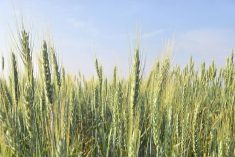CHICAGO (Reuters) — U.S. corn and soybean futures fell on Tuesday as forecasts for slightly wetter-than-expected weather across the U.S. Midwest prompted a round of profit-taking following sharp gains the previous two sessions, traders said.
The weakness spilled over into the wheat market, but declines were limited by good demand on the export market and concerns about cold weather damaging the crop in South America.
Corn had the biggest loss with the front-month contract shedding 3.1 percent, its biggest decline in two weeks. Soybeans, which were more vulnerable to the scorching temperatures reported across the Midwest, fell nearly one percent.
Read Also

USDA considering economic aid for farmers this fall, says secretary
The U.S. Department of Agriculture is working with Congress to evaluate whether economic aid might be needed for the nation’s farmers this fall amid trade disputes and record-high yields, Agriculture Secretary Brooke Rollins said on Monday.
“They lowered the temperatures and they added a little bit of rain,” Chris Robinson, senior trader and analyst at Top Third Ag Marketing, said of the new weather view. “That is really all it takes. If you get the rain, this crop is going to be in better shape.”
CBOT September corn was down 16 cents at $4.99-3/4 a bushel, with new-crop December sliding 14-1/4 cents at $4.86-1/4. CBOT September wheat was four cents lower at $6.50-3/4 a bushel.
CBOT September soybeans were down 13-3/4 cents at $14.14 a bushel. The new-crop November soybean contract was 19 cents lower at $13.70-1/2.
Soybeans rallied throughout much of the morning, pushing the new-crop contract to an 11-month high. The market turned lower when the midday updates to the weather models raised the possibility of showers providing relief to the crop in places like Iowa during the next few weeks.
The new outlook for the second week of September was of particular interest.
“It scatters showers and thunderstorms more numerously across the Midwest, and there is a substantial cold surge that occurs the eighth through the eleventh,” said Drew Lerner, meteorologist at World Weather Inc.
The U.S. Agriculture Department’s report on Monday afternoon showed that crop yields for both corn and soybeans were at risk of reduction if the weather, which has turned hot and dry during the past month, did not provide some relief, traders said.
Ratings for U.S. soybeans dropped four percentage points to 58 percent good to excellent as of Aug. 25. The drop was bigger than analysts expected.
Corn ratings were 59 percent good to excellent, USDA said, two percentage points lower than a week earlier and in line with market expectations.














